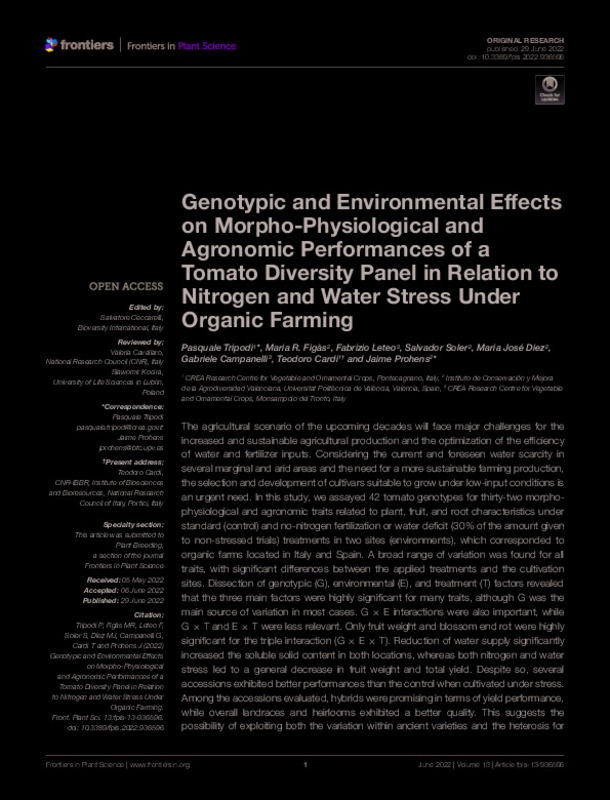JavaScript is disabled for your browser. Some features of this site may not work without it.
Buscar en RiuNet
Listar
Mi cuenta
Estadísticas
Ayuda RiuNet
Admin. UPV
Genotypic and environmental effects on morpho-physiological and agronomic performances of a tomato diversity panel in relation to nitrogen and water stress under organic farming
Mostrar el registro sencillo del ítem
Ficheros en el ítem
| dc.contributor.author | Tripodi, Pasquale
|
es_ES |
| dc.contributor.author | Figás-Moreno, María Del Rosario
|
es_ES |
| dc.contributor.author | Leteo, Fabrizio
|
es_ES |
| dc.contributor.author | Soler Aleixandre, Salvador
|
es_ES |
| dc.contributor.author | Díez Niclós, Mª José Teresa De Jesús
|
es_ES |
| dc.contributor.author | Campanelli, Gabriele
|
es_ES |
| dc.contributor.author | Cardi, Teodoro
|
es_ES |
| dc.contributor.author | Prohens Tomás, Jaime
|
es_ES |
| dc.date.accessioned | 2023-01-11T19:01:01Z | |
| dc.date.available | 2023-01-11T19:01:01Z | |
| dc.date.issued | 2022-06-29 | es_ES |
| dc.identifier.uri | http://hdl.handle.net/10251/191253 | |
| dc.description.abstract | [EN] The agricultural scenario of the upcoming decades will face major challenges for the increased and sustainable agricultural production and the optimization of the efficiency of water and fertilizer inputs. Considering the current and foreseen water scarcity in several marginal and arid areas and the need for a more sustainable farming production, the selection and development of cultivars suitable to grow under low-input conditions is an urgent need. In this study, we assayed 42 tomato genotypes for thirty-two morphophysiological and agronomic traits related to plant, fruit, and root characteristics under standard (control) and no-nitrogen fertilization or water deficit (30% of the amount given to non-stressed trials) treatments in two sites (environments), which corresponded to organic farms located in Italy and Spain. A broad range of variation was found for all traits, with significant differences between the applied treatments and the cultivation sites. Dissection of genotypic (0), environmental (E), and treatment (T) factors revealed that the three main factors were highly significant for many traits, although G was the main source of variation in most cases. G x E interactions were also important, while G x T and E x T were less relevant. Only fruit weight and blossom end rot were highly significant for the triple interaction (G x E x T). Reduction of water supply significantly increased the soluble solid content in both locations, whereas both nitrogen and water stress led to a general decrease in fruit weight and total yield. Despite so, several accessions exhibited better performances than the control when cultivated under stress. Among the accessions evaluated, hybrids were promising in terms of yield performance, while overall landraces and heirlooms exhibited a better quality. This suggests the possibility of exploiting both the variation within ancient varieties and the heterosis for yield of hybrids to select and breed new varieties with better adaptation to organic farming conditions, both under optimal and suboptimal conditions. The results shed light on the strategies to develop novel varieties for organic farming, giving hints into the management of inputs to adopt for a more sustainable tomato cultivation. | es_ES |
| dc.description.sponsorship | This work has been funded by the European Union's Horizon 2020 Research and Innovation Programme under grant agreement no. 774244 (Breeding for resilient, efficient and sustainable organic vegetable production; BRESOV). | es_ES |
| dc.language | Inglés | es_ES |
| dc.publisher | Frontiers Media SA | es_ES |
| dc.relation.ispartof | Frontiers in Plant Science | es_ES |
| dc.rights | Reconocimiento (by) | es_ES |
| dc.subject | Tomato | es_ES |
| dc.subject | Local varieties | es_ES |
| dc.subject | Nitrogen stress | es_ES |
| dc.subject | Water stress | es_ES |
| dc.subject | Sustainability | es_ES |
| dc.subject | Organic farming | es_ES |
| dc.subject | Genotype x environment interaction | es_ES |
| dc.subject | Breeding | es_ES |
| dc.subject.classification | GENETICA | es_ES |
| dc.title | Genotypic and environmental effects on morpho-physiological and agronomic performances of a tomato diversity panel in relation to nitrogen and water stress under organic farming | es_ES |
| dc.type | Artículo | es_ES |
| dc.identifier.doi | 10.3389/fpls.2022.936596 | es_ES |
| dc.relation.projectID | info:eu-repo/grantAgreement/EC/H2020/774244/EU | es_ES |
| dc.rights.accessRights | Abierto | es_ES |
| dc.contributor.affiliation | Universitat Politècnica de València. Instituto Universitario de Conservación y Mejora de la Agrodiversidad Valenciana - Institut Universitari de Conservació i Millora de l'Agrodiversitat Valenciana | es_ES |
| dc.contributor.affiliation | Universitat Politècnica de València. Escuela Técnica Superior de Ingeniería Agronómica y del Medio Natural - Escola Tècnica Superior d'Enginyeria Agronòmica i del Medi Natural | es_ES |
| dc.description.bibliographicCitation | Tripodi, P.; Figás-Moreno, MDR.; Leteo, F.; Soler Aleixandre, S.; Díez Niclós, MJTDJ.; Campanelli, G.; Cardi, T.... (2022). Genotypic and environmental effects on morpho-physiological and agronomic performances of a tomato diversity panel in relation to nitrogen and water stress under organic farming. Frontiers in Plant Science. 13:1-19. https://doi.org/10.3389/fpls.2022.936596 | es_ES |
| dc.description.accrualMethod | S | es_ES |
| dc.relation.publisherversion | https://doi.org/10.3389/fpls.2022.936596 | es_ES |
| dc.description.upvformatpinicio | 1 | es_ES |
| dc.description.upvformatpfin | 19 | es_ES |
| dc.type.version | info:eu-repo/semantics/publishedVersion | es_ES |
| dc.description.volume | 13 | es_ES |
| dc.identifier.eissn | 1664-462X | es_ES |
| dc.identifier.pmid | 35845687 | es_ES |
| dc.identifier.pmcid | PMC9277548 | es_ES |
| dc.relation.pasarela | S\470438 | es_ES |
| dc.contributor.funder | COMISION DE LAS COMUNIDADES EUROPEA | es_ES |
| dc.subject.ods | 02.- Poner fin al hambre, conseguir la seguridad alimentaria y una mejor nutrición, y promover la agricultura sostenible | es_ES |
| upv.costeAPC | 3630 | es_ES |








